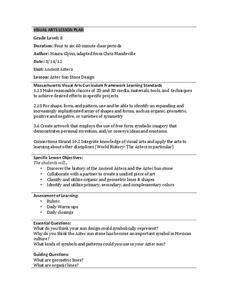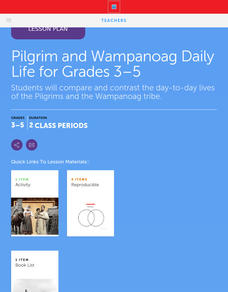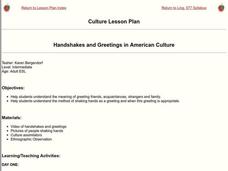Maryland Department of Education
The Concept of Diversity in World Literature Lesson 1: Unit Introduction
To launch a unit study of the concept of diversity in World Literature, class members compare Chinua Achebe's essay, "An Image of Africa: Racism in Conrad's Heart of Darkness" and Richard Rodriguez's essay, "The Chinese in All of...
Curated OER
Ancient Aztecs
Is it a calendar? A religious symbol? A political statement? One thing for certain is that Aztec sun stone designs remain an important symbol in Mexican cultural art. Young artists craft their own Aztec Sun design incorporating ideas...
Channel Islands Film
Once Upon a Time (Saxipak’a): Lesson Plan 4
How did the environment and natural resources found on the Channel islands influence the culture of the Chumash? Archaeology meets technology in an activity designed for middle schoolers. After viewing West of The West's documentary Once...
US Institute of Peace
Perspectives on Peace
Is peace simply the absence of war, or is there more to the story? Young social scientists define peace in the second installment of a 15-part series. Groups work together to explore cultural concepts of peace and the peacemaking process...
Curated OER
Looking at the World
This set of discussion questions prompts learners to think about their place in the global community. These questions encourage them to consider food availability, free community services, schooling, and what life in other countries...
Maryland Department of Education
The Concept of Diversity in World Literature Lesson 4: Proverbs
"Eneke the bird says since men have learnt to shoot without missing, he has learnt to fly without perching." As part of their study of Things Fall Apart, class members read Paul Hernadi and Francis Steen's essay, "The Tropical Landscapes...
US Institute of Peace
Nonverbal Communication
What is your body saying that maybe your words aren't? Scholars explore the vast world of the subtle, and not-so-subtle, nonverbal communication cues through group and individual work. Lesson seven in a series of peacebuilding exercises...
Scholastic
Pilgrim and Wampanoag Daily Life for Grades 3-5
Thirteen steps make up a lesson plan that challenges pupils to compare and contrast the daily lives of Pilgrims and the Wampanoag tribe. Learners revisit the Graffiti Wall then break into small groups for an investigative reading...
Curated OER
Microbes Are Everywhere - Biology Teaching Thesis
Students are able to list at 3 rules for operating in a laboratory and to explain why each is important. They are able to identify problems with laboratory scenarios presented by the teachers. Students execute a lab protocol using...
Curated OER
Compare the Presidents
How are Nicolas Sarkozy and Barack Obama similar? How are they different? Look at two visual representations of them; what kind of first impression does they give you? After comparing the presidents, learners complete a proverb matching...
Curated OER
Shall We Dance?
This four to five day mini dance unit has many components. Discussion on what makes a good dance partner, research on famous dancing pairs, as well as learning a choreographed piece in class. The class learns a short dance sequence and...
K12 Reader
What is a Tribal Government?
How are tribal governments similar to local or state governments? After reading a short article on tribal governments, individuals draw evidence from the provided article to respond to this reading comprehension question.
Curated OER
Creating a Caring Culture: Appreciating the Diversity of Your School
Students explore community diversity. In this character education lesson, students read the book Is There Really a Human Race? discussing it with their classmates and teachers. Students design paper dolls to represent themselves and...
Intel
Starquest
Almost every ancient culture observed the stars and saw pictures in the patterns. Studying stars allowed them to guide travelers, determine when to plant crops, when to harvest food, and the stories surrounding the images include some of...
Curated OER
What’s your Name?
Youngsters work to build empathy, cultural understanding, and a sense of self as they uncover the story behind their own names. They read the book, The Name Jar, discuss immigration and how it feels to be in a new place. Then, they...
Maryland Department of Education
The Concept of Diversity in World Literature Lesson 5: The Tragic Hero
Should identifying a tragic hero be based on a universal definition or a definition based on the morals and values of a specific culture? As part of a study of Things Fall Apart, class members read Sylvia Plath's "Colossus" and then...
Curated OER
Say Hi to Haibun Fun
What is a haibun? With this interesting lesson plan, writers will experience the Japanese writing form haibun, identify elements important to Japanese writing styles, analyze a haibun, and compose their own. Different from the typical...
Curated OER
1920s Variety Show
To better understand the cultural achievements of the Harlem Renaissance and become familiar with its major figures, class members examine a painting by Aaron Douglas and a poem by Langston Hughes and compare how the artists develop...
Curated OER
An Early American Culture
Learners identify the locations of the Hopewell culture. In this map skills lesson, students use a globe to mark several locations of the Hopewell culture.
Curated OER
What is Hunger and Who are the Hungry?
Students aim to explain why we need food, to know that we need many different foods and to know who is hungry in the world.
Curated OER
Handshakes and Greetings in American Culture
Students explore the meaning of greeting friends, acquaintances, strangers and family and learn when shaking hands is appropriate.
Curated OER
JAPANESE CULTURE
First graders explore what life in Japan is like including, home and daily life, food and eating customs, school life, games and sports, holiday customs, and religion.
Curated OER
Shizuko’s Daughter: Before, During, After Lesson Plan
Shizuko's Daughter by Kyoko Mori presents a vivid picture of Japanese culture and history. As kids read through the third chapter, they find novel-specific vocabulary to enhance their understanding and use context clues to...
Curated OER
The age of majority: How old is old enough?
Students perform research on the internet in order to create an examineing of World War II. The integration of technology into research gives them access to more information.























